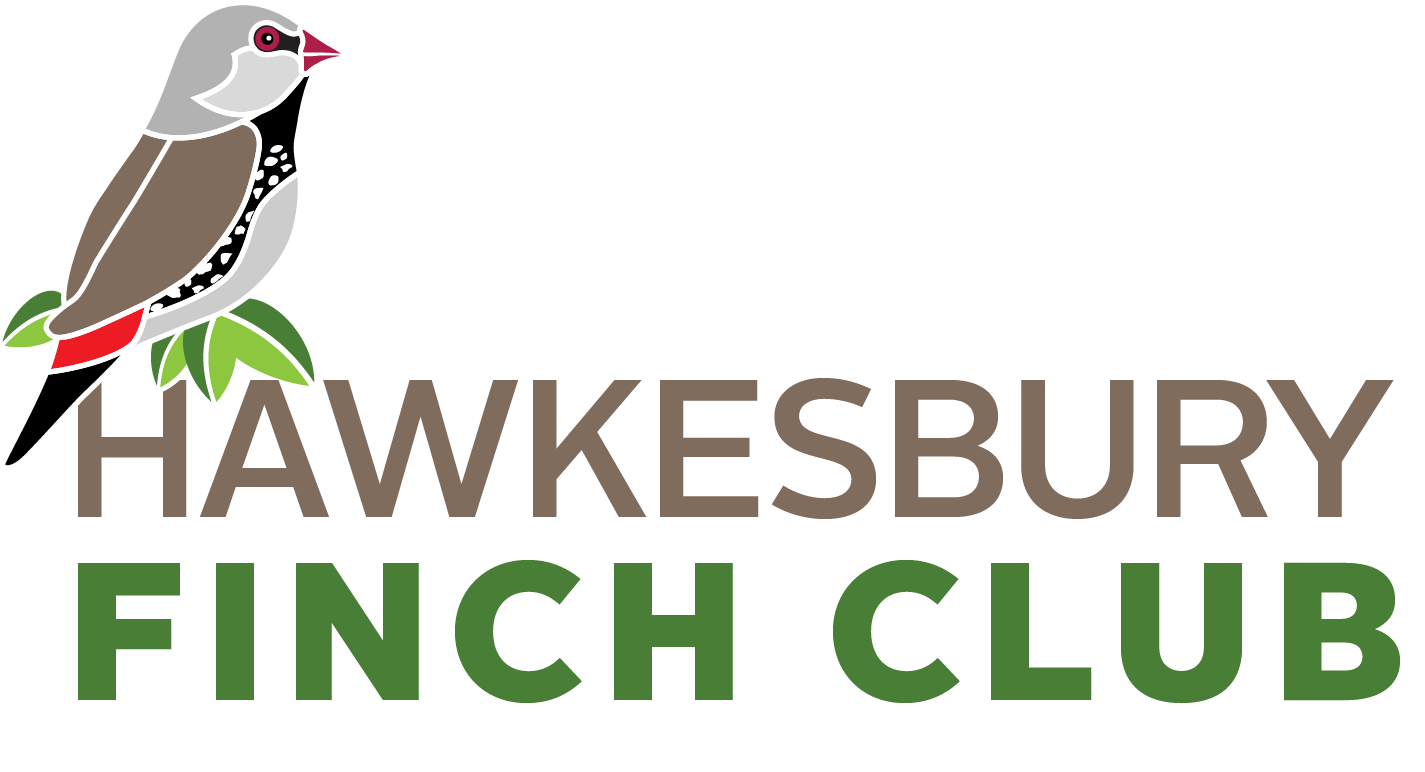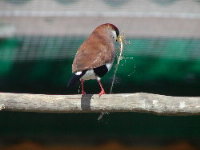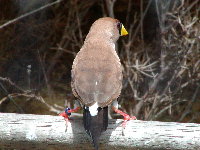Masked Grassfinch. Photo: Julian Teh
Article kindly provided by Doug Hill & Marcus Pollard
Availability
The Masked Finch Poephila personata is uncommon in Australian aviaries at times, and appears to go through a number of peaks and troughs over the years. The White-eared Mask Finch, P. personata leucotis, is even rarer and extremely hard to find in captivity although a breeder in WA has had extremely good success with the species.
Sexing
To the untrained eye it can be extremely difficult trying to sex the Masked Finch. It can be difficult at times for the trained eye as well! Perhaps the best method is to look at the size of the birds as the hen tends to be slightly smaller than the male. My favourite way of sexing these birds is to check the size of the black mask on the face. If you hold the birds the males’ mask extends back from the beak to a greater extent than the females – when viewed from above this is more obvious. Also the male has a richer brown colouration to the top of his head which tends to be more pronounced when the birds are in breeding condition. Apparently there are differences in the ‘trouser stripe’ colour but we are not familiar with this method of sexing.
Mutations
There are only two mutations that we are aware of in this species are the Fawn and the White - both are rarely seen.
Distribution
Northern Australia from around Derby in Western Australia through to the Cape York Peninsula in Queensland.
Adult & Juvenile Masked Grassfinches. Photo: Julian Teh
Compatibility
Unlike their cousins the Longtail and the Parson they are docile in a mixed collection. They do best as a small colony of 3 or more pairs but will breed when kept as a single pair. They show no inclination to interfere with the nests of smaller waxbill species – unlike their cousins! They may be a little timid when combined with the more ‘boisterous’ Australian such as Diamond Sparrows, Redbrows and Blue-face Parrotfinches but are fine with the majority of waxbills and other smaller finches.
Ease of breeding (1 easy-10 difficult)
5/10 – can be difficult to breed even if given the right conditions. The right conditions include being given a diet of good and plentiful half ripe seeding heads and large amounts of live food. Many first time parents are notoriously bad bringing youngsters out well before ‘sensible’ and many are half feathered and can succumb on cool nights. Many pairs are also touchy when nest inspection is undertaken and may desert.
Purchasing your bird
To purchase Masks you would need to find breeders as they are becoming uncommon in most bird outlets. It would be beneficial to you to buy your pairs of birds from different outlets, so you will most likely obtain different strains of the species. That will give you better breeding results and keep your gene pool diverse. If you are unsure of where to find a reputable breeder ask at your nearest Finch Society or avicultural club.
Juvenile Mask.
Good points to look for
Size of the bird – especially avoid a bird with a thin keel bone. Well coloured yellow beak. Clear bright eyes. The bird is always on the move. The bird must be in good tight feather and the feathers to have a nice sheen to them. Clean mandibles, legs and a clear clean vent are essential. The colours of the bird are strong.
Faults to look for
Birds that are lethargic. Soiled vent – especially common in this species. Fluffed up with closed eyes. Overgrown toenails. Missing feathers. A dulled appearance to the feathers. When moved these finches, in common with other members of the Poephila genus, show a tendency to scour. This is usually easily treated with one of the multitude of electrolyte replacers on the market – if not you will have a real problem on your hands.
Adult Masked Grassfinch.
“The Masked Grassfinch is one of my all time favourite finches. Their beautiful colour scheme, temperate nature and close social structure have always impressed me.”
Aviary or breeding cabinet
These birds are ill suited to breeding cages and will do much better in larger well-planted aviaries. Regardless of the housing situation, whether cabinet or aviary, it must be free of draughts as this bird is prone to pneumonia in cooler climates.
Breeding season
In the Sydney area it is best to try and breed them during the warmer months of spring summer and autumn although they will breed through the winter months if given the right conditions. I have found that the Masks that I have had ceased breeding in the hotter months of summer and recommenced about the second week in March. If you intend to attempt breeding them during the colder months, then you should ensure that your diet has the correct amount of oils or you may very well have egg binding problems. In cooler climes they tend to breed early - around late August early September – which can lead to problems as the weather can be very unsettled during this period.
Off-season feeding
I must point out here that I personally do not believe in the austerity diet.
An austerity diet of mixed seeds, grits, cuttlebone and eggshells is O.K. A fresh supply of some seeding grasses is also recommended. Not too much at a time in the off-season as it could easily scour the birds. I do not feed my birds an austerity diet now and never will.
Should I feed soft foods?
A good mix of egg and biscuit formula can be fed to the birds on a daily basis. Fruit such as red apple and paw-paw can be offered as well. A small amount of Madeira cake may be offered.
What green feed?
Fresh grass seed can be fed daily in the breeding season. Other green feed can consist of Dandelion, Milk thistle, Chickweed, Endive, Kale and Chicory. I also feed my birds fresh grasses with the roots attached. The birds seem to enjoy picking around the roots and must be picking up small tit-bits from them.
What live food?
Masks do very well when supplied with copious amounts of Termites. They will readily take Gentles (Maggots) and Mealworms and often show a preference for maggots over mealworms.
Breeding season feeding
At the end of winter this is the time to instigate your breeding-feeding program. This is when you start to slowly give your birds some extra bits in their feed tray. Do not start with large amounts. To begin with let the birds build up to the extra live food and green seeding grasses. Too much too soon can easily cause all types of intestinal problems – especially scours in this species.
What age do they breed?
Young Masks can be bred from at around 9 months of age. It is best not to breed them before this age as it will detract from your breeding expectations, so you are best advised to curb your impatience and leave them to mature properly before breeding from young birds – usually 12 months after they were bred.
“Unlike their cousins, the Longtail and the Parson, they are docile in a mixed collection. They do best as a small colony of 3 or more pairs but will breed when kept as a single pair.”
What if I lose a mate?
Pair bonding is very strong in the Mask Finch and if you happen to lose one of a pair, it is not always easy to pair another with the surviving bird. It is best to pair them when they are still young by placing a number of uncoloured birds together and letting them choose their own mates. If you are having no luck in pairing a new bird with the surviving, try separating them for at least two months and then reintroducing the cock to the hen.
Nesting receptacles
Masks do not seem to show a preference for nesting receptacles and will construct their breeding nests in the brush of the aviary. I have had them use nesting boxes as sleep nests during the winter but mine have never bred in these. They do like dried grasses and bracken fern placed in large wire cylinders hung from the roof of the aviary. They will build in a very unobtrusive place!
Nesting materials
Nesting materials can vary from November grasses for the nest lining and coarser grasses for the exterior – they are big fans of the Ehrharta grass family for the outer lining or witch grass. They build their own nest in the shrubbery attached to the walls of the aviary. I also supply the birds with coarser grasses that they use for the outer shell of the nest. Masks use a copious amount of white feathers to line the nest along with a large number of pieces of charcoal.
The nest
The nest, if built in the brush, is a smallish nest with an entrance hole in one end. They often use long leaves from the tussock grasses and weave these into a ball. They use a coarse grass for the outer nest and may use softer November grass for lining the interior together with a large amount of white feathers, Emu feathers and even pampas grass heads. The nest is often well hidden and many appear to have an entrance tunnel which opens into a feather filled chamber.
Mating behavior
The mating ritual begins with the male hopping from branch to branch in the near vicinity of the female. The female will usually sit in the one position and allow the male to do his thing. The male will have a piece of grass in his beak at most times and begin a hopping and bobbing movement towards the female. Both of the birds point the tail in each other’s direction. The hen will begin to quiver her tail when she is ready to copulate.
Eggs
It is not unusual to have up to 6 white eggs in the nest with most young that are hatched raised to maturity. However, 3-5 eggs are usually laid.
Brooding time
It generally takes around 14 days to incubate the eggs. There may be a day or twos difference in cooler climates.
Fledging time
Fledging usually takes around 21 days. In the first few days after leaving the nest the young can be highly ‘excitable’ and are very prone to damaging themselves in these days.
Independence from the parents
Young Masks can be left with the parents as long as it does not create an overcrowding problem in your aviary. If you want to separate the young from the parents then the birds would have to be at least 5-6 weeks of age. I have always left them until their beaks are starting to turn yellow before separating them.
“Mask’s are a great bird to show as they look absolutely terrific when in good feather. I think that they are the, along with the Java Sparrow, one of the neatest birds that you could get for the show bench.”
How long do the young stay with the parents?
It is best to leave the young with the parents for a further 4 weeks. I have seen no indication that the young interfere with future nests of youngsters.
What do I feed the fledged young?
The young birds can be given the same diet as the parents. I include even more half ripe seeding heads when the weaning process from the parents begins to start that is when the young are out of the nest for about two weeks.
Masked Grassfinches & Long-tailed Grassfinches. Photo: Julian Teh
When do I ring the young?
The young can be rung immediately after they have left the nest. If you leave it too long the ring will not slip over the toes. When ringing young birds with an enclosed ring, be careful not to damage the foot or toes over which you are slipping the ring.
Separating the pairs
It is not necessary to separate the pairs, as they will regulate themselves for their breeding needs. However, if you have a male that persists on putting the hen down again and again, then I would most certainly isolate the pair for a period of a couple of months, so that the hen would have time to recover and build herself up again. As they have such a strong pair bond separation is a last resort.
Showing your bird
Mask’s are a great bird to show as they look absolutely terrific when in good feather. I think that they are the, along with the Java Sparrow, one of the neatest birds that you could get for the show bench. Once the bird has settled down and gets used to people being around it does look good when viewed up close. Judges will look for birds in tip-top condition without any pinfeathers showing at all. The colour of the mandible is taken into consideration with the brighter the yellow beak the better. Also the legs and mandible must be clean and no flaking present. The colour of the face mask, especially on the male, must be dark and extend to the mid-rear of the eye. The tail must be of a good length and not damaged at all. With the White-eared Mask all of the above is appropriate for them and the thing that the judges will look for on them is the amount of the white patch and the cleanness of the white ear patch.
White-eared Masked Grassfinches.
Gene pool
The gene pool for the Mask Finch in Australian aviaries is tenuous and greater breeding effort should be applied lest we lose this species. Part of this is because the Mask lacks the more ‘flamboyant’ nature of the Longtail and Parson. They are also duller which often makes them less desirable in some peoples eyes.
Please note: If you have other Poephila species (Longtails and Parsons) in your aviaries, they will interbreed with the Mask Finch, giving you a hybrid bird that is of no use, thus not only ruining your breeding lines, not only putting the gene pool of all three species into jeopardy. I believe that many of the hybrids between these three species are fertile.
Life Expectancy
Masks live to around 7 or 8 years with the best breeding time of 2 to 5 years.
Common ailments
Masks are, in my opinion, the most delicate of the Poephila family. They appear to be very prone to pneumonia in cooler climates – which, fortunately, is fairly easily treated with antibiotics if you get to them in time. A good worming and Coccidial program is essential. Again in cooler climates they are best removed from open aviaries for the winter and placed in a warmer environment until the weather warms up, sorry, IF it warms up! These guys also spend a great deal of time on the ground so a thorough worming regime is essential and it has been reported that Mask finches have a tapeworm that does not require an intermediate host so a good tape worming medication would appear to be even more critical in this species.
Summary
The Mask is one of my all time favourite finches. Their beautiful colour scheme, temperate nature and close social structure have always impressed me. I must admit that I have not, until recently, been too successful in breeding them but have now established a beautiful little colony. They will always hold a place for me as an aviary bird and I have no hesitation in recommending them to anyone who has an eye for a challenge! You can ill afford not to have a thorough worming and Coccidia program in place for this species as these both appear to be high on the cause of deaths for these guys. If you have time to watch the social dynamics of a small flock of these birds you will never be without a colony or two in your aviaries. Personally I believe they are a high maintenance bird, especially in cooler climes, but well worth the effort in the long run!








